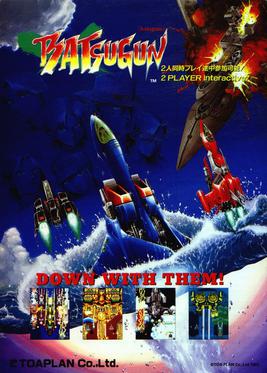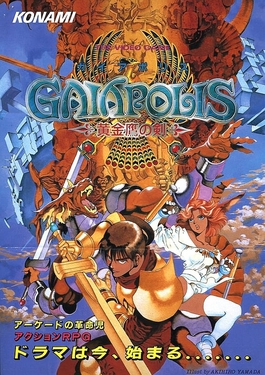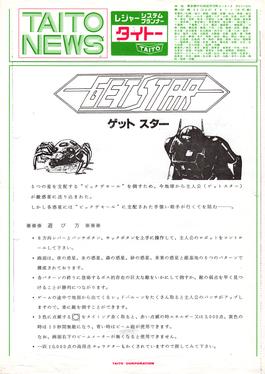
Zero Wing is a 1989 side-scrolling shooter arcade video game developed by Toaplan and originally published in Japan by Namco and in North America by Williams Electronics. Controlling the ZIG space fighter craft, players assume the role of protagonist Trent in a last-ditch effort to overthrow the alien cyborg CATS. It was the eighth shoot 'em up game from Toaplan, and their fourteenth video game overall.

Toaplan Co., Ltd. was a Japanese video game developer based in Tokyo responsible for the creation of a wide array of scrolling shooters and other arcade video games. The company was founded in 1979 but its gaming division was established in 1984 by former Orca and Crux employees, who wanted to make games, after both companies declared bankruptcy. Their first shoot 'em up game, Tiger-Heli (1985) on arcades, was a success and helped establish Toaplan as a leading producer of shooting games throughout the 1980s and 1990s that would continue to characterize their output.

Tiger-Heli is a vertically scrolling shooter game developed by Toaplan and released for arcades in 1985. It was published in Japan by Taito and in North America by Romstar. Controlling the titular attack helicopter, the player must fight endless waves of military vehicles while avoiding collision with their projectiles and other obstacles. The Tiger-Heli has a powerful bomb at its disposal that can clear the screen of enemies when fired. It was the first shoot 'em up game from Toaplan, and their third video game overall.

Twin Cobra, known as Kyukyoku Tiger in Japan, is a vertically scrolling shooter developed by Toaplan and released for arcades in 1987 by Taito in Japan and Europe, then in North America by Romstar. It is a sequel to the 1985 arcade game Tiger-Heli. Controlling the titular attack helicopter, the players must fight endless waves of military vehicles while avoiding collision with their projectiles and other obstacles. It was the fourth shoot 'em up game from Toaplan, and their tenth video game overall. It was ported to multiple platforms, with each done by different third-party developers that made several changes or additions.

Batsugun is a 1993 vertically scrolling bullet hell arcade video game originally developed and published by Toaplan in Japan and Europe by Taito, as well as Korea by Unite Trading. The last shoot 'em up created by Toaplan, the title takes place on a distant Earth-like planet where a global takeover operative led by king Renoselva A. Gladebaran VII is set into motion, as players assume the role from one of the six fighter pilots conforming the Skull Hornets squadron taking control of submersible jets in a last-ditch effort to overthrow the invading military force from the planet. Its gameplay mainly consists of shooting mixed with role-playing game-esque elements using a main two-button configuration.

Enterbrain (エンターブレイン), formerly Enterbrain, Inc., is a Japanese publisher and division of Kadokawa Future Publishing founded on January 30, 1987 as ASCII Film Co., Ltd.. Magazines published by Enterbrain are generally focused on video games and computer entertainment as well as video game and strategy guides. In addition, the company publishes a small selection of anime artbooks. Enterbrain is based in Tokyo, Japan, with a paid-in capital of 410 million yen. Enterbrain's current president is Hirokazu Hamamura.

Puzzle Uo Poko is an arcade puzzle game developed by Cave and distributed by Jaleco.

Hellfire is a 1989 horizontally scrolling shooter arcade video game originally developed by Toaplan and published in Japan by Taito and North America by U.S.A. Games. The first horizontal shoot 'em up title to be created by Toaplan, the game takes place in the year 2998 where a space matter known as Black Nebula created by robot dictator Super Mech spreads and threatens to engulf human-controlled galaxies, as players assume the role of Space Federation member Captain Lancer taking control of the CNCS1 space fighter craft in a surprise attack to overthrow the enemies with the fighter craft's titular weapon.

Cotton: Fantastic Night Dreams is a scrolling shooter video game developed by Success and originally released in Japanese arcades in 1991. The first installment in the Cotton series, players assume the role of the young witch Cotton who, alongside her fairy companion Silk, sets out on her broomstick on a quest to defeat several monsters and get her Willow candy. Its gameplay mainly consists of shooting mixed with role-playing game elements using a main two-button configuration. It ran on the Sega System 16 hardware.

Knuckle Bash is a 1993 side-scrolling beat 'em up arcade video game developed and published by Toaplan in Japan, as well as North America and Europe by Atari Games. It is notable for being one of the few titles by Toaplan that has not received any official port to home consoles as of date.

Gaiapolis is a 1993 action role-playing beat 'em up arcade game developed and published by Konami. Taking place in a fantasy world, the game follows prince Gerard Himerce, joined by the half-human fairy Elaine Shee and the exiled dragon duke Galahad, seeking vengeance for destruction of his homeland against the Zar Harc empire led by the King of Darkness and prevent him from resurrecting an ancient demon. Through the journey, players explore and search for items to progress and power-ups, fighting enemies and bosses, and gaining experience points to increase their character's maximum health and level.

Monthly Arcadia was a Japanese arcade game magazine, published by Enterbrain.

Dogyuun is a 1992 vertically scrolling shooter arcade video game developed and published by Toaplan. Set on the colonized fictional planet of Dino in the future, where an alien race of metallic robots have invaded a police communication center and held its inhabitants as hostages, players assume the role of two fighter pilots taking control of the Sylfers bomber space fighter crafts in an revenge attempt to overthrow the invaders and free the surviving colonists after one of their comrades is killed by one of them during a reconnaissance assignment.

Guardian is a 1986 side-scrolling beat 'em up arcade video game developed by Toaplan and published in Japan by Taito and North America by Kitkorp. In the game, players assume the role of a robot fighting against a multitude of enemies and bosses across six locations on a futuristic science fiction setting. It is notable for marking the debut of Twin Cobra and Hellfire artist Kōetsu Iwabuchi in the video game industry, serving as its graphic designer.

Performan is an action arcade video game developed by Toaplan and published exclusively in Japan by Data East in April 1985. In the game, players assume the role of the titular robot in order to defeat enemies across multiple stages. The title is notable for being created by most of the same team that previously worked on several projects at Orca and Crux before both companies declared bankruptcy. A group of employees from the two gaming divisions would go on to form Toaplan as a result. Performan is one of the few titles by Toaplan that has not received any official port to home consoles.

FixEight is a run and gun arcade video game developed and published by Toaplan in July 1992. The spiritual successor to 1990's Out Zone, it is notable for being one of the few titles by Toaplan that has not received any official port to home consoles as of date. Set in a future where an alien race known as the Gozzu from the fictional planet Fortuna invaded the universe, players are tasked by the Galactic Federation government with an extermination mission against the invaders by assuming the role of one of the eight mercenaries.

Snow Bros. 2: With New Elves is a 1994 platform arcade video game developed and published by Toaplan under their Hanafram label. One of the last games to be created by Toaplan, it is the sequel to Snow Bros., which was released earlier in 1990 on multiple platforms. In the game, players assume the role of one of the playable characters to rescue a kidnapped princess from captivity.

Enma Daiō is a 1993 hybrid quiz/lie detector arcade video game developed by Toaplan and published exclusively in Japan by Taito. In the game, players answer a number of question. As of 2019, the rights to the title is owned by Tatsujin, a company founded in 2017 by former Toaplan member Masahiro Yuge and now-affiliate of Japanese arcade manufacturer exA-Arcadia alongside many other Toaplan IPs.

Tobe! Polystars is a scrolling shooter arcade video game developed and originally published by Konami in March 1997. It has not received any official port to home consoles after its arcade release. It is the first game that ran on the Konami M2 hardware, which was Konami's version of the Panasonic M2. Taking place on the fictional planet Polygon, where the secret Perfect Primitive Polygon association led by Material the Third have invaded its inhabitants, players assume the role of police officers Poly and Stan from the titular squad in order to restore peace on their home.

Cotton 2: Magical Night Dreams is a 1997 scrolling shooter arcade video game developed by Success and published by Tecmo. The fourth installment in the Cotton franchise, it is the arcade sequel to Cotton: Fantastic Night Dreams. In the game, players assume the role of either the titular young witch or her rival Appli who, alongside their companions Silk and Needle, sets out on a quest to defeat several monsters and retrieve the missing "Bluewater Willow" candy to Pumpkin Kingdom. Its gameplay is similar to the first game, consisting of shooting mixed with fighting and role-playing game-esque elements using a main three-button configuration. It ran on the ST-V hardware.





















